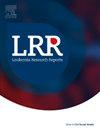Baseline erythropoietin level predicts Luspatercept response in Chinese patients with myelodysplastic syndrome: a propensity score-matched analysis
IF 0.9
Q4 HEMATOLOGY
引用次数: 0
Abstract
Background
Luspatercept is a novel erythroid maturation agent approved for treating transfusion-dependent anemia in myelodysplastic syndrome (MDS). However, predictive biomarkers and real-world data in Asian populations remain limited.
Methods
We conducted a retrospective cohort study of 66 MDS patients from two Chinese centers, including 22 patients treated with luspatercept and 44 matched controls. Propensity score matching (1:2) was used to adjust for age, sex, risk category, baseline hemoglobin, transfusion burden, and erythropoietin (EPO) levels. Primary endpoints were red blood cell transfusion independence (RBC-TI) ≥8 weeks and hematologic improvement–erythroid (HI-E).
Results
By week 12, 54.5 % of luspatercept-treated patients achieved RBC-TI, compared to 29.5 % in the control group (P < 0.05). Patients with baseline EPO <500 IU/mL had higher RBC-TI rates than those with EPO ≥500 IU/mL (63.6 % vs. 45.5 %). Multivariate analysis identified baseline EPO <500 IU/mL as an independent predictor of response (OR=2.36, 95 % CI: 1.24–4.52, P = 0.008). Safety was acceptable, with no treatment discontinuation due to adverse events.
Conclusion
This first matched real-world study of luspatercept in Chinese MDS patients confirms its efficacy in reducing transfusion needs and identifies baseline erythropoietin level as a clinically meaningful predictor of response. These findings support the integration of EPO-guided selection in personalized treatment strategies.
基线促红细胞生成素水平预测中国骨髓增生异常综合征患者的Luspatercept反应:倾向评分匹配分析
背景:luspatercept是一种新的红细胞成熟剂,被批准用于治疗骨髓增生异常综合征(MDS)的输血依赖性贫血。然而,亚洲人群的预测性生物标志物和实际数据仍然有限。方法我们对来自中国两个中心的66例MDS患者进行回顾性队列研究,包括22例接受luspaterceept治疗的患者和44例匹配的对照组。倾向评分匹配(1:2)用于调整年龄、性别、风险类别、基线血红蛋白、输血负担和促红细胞生成素(EPO)水平。主要终点为红细胞输血独立性(RBC-TI)≥8周和血液学改善-红细胞(HI-E)。结果到第12周,54.5%的luspaterept治疗患者达到了RBC-TI,而对照组为29.5% (P <;0.05)。基线EPO和lt为500 IU/mL的患者比EPO≥500 IU/mL的患者有更高的RBC-TI率(63.6%对45.5%)。多变量分析确定基线EPO和lt 500 IU/mL是反应的独立预测因子(OR=2.36, 95% CI: 1.24-4.52, P = 0.008)。安全性是可接受的,没有因不良事件而中断治疗。本研究首次在中国MDS患者中应用luspatercept,证实了其减少输血需求的有效性,并确定了基线促红细胞生成素水平是临床有意义的反应预测指标。这些发现支持将epo引导的选择纳入个性化治疗策略。
本文章由计算机程序翻译,如有差异,请以英文原文为准。
求助全文
约1分钟内获得全文
求助全文

 求助内容:
求助内容: 应助结果提醒方式:
应助结果提醒方式:


